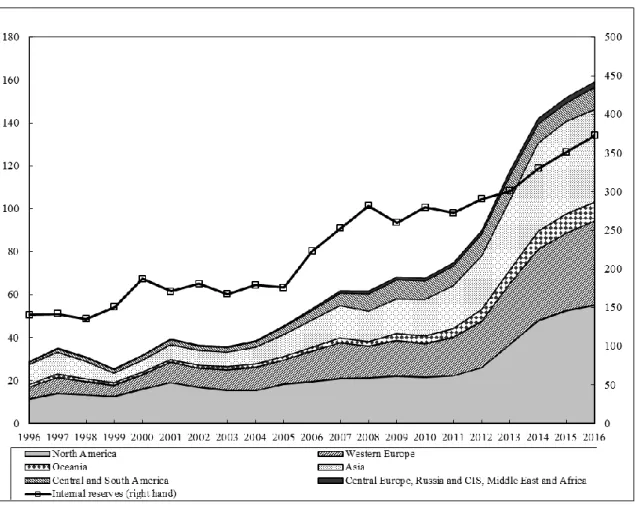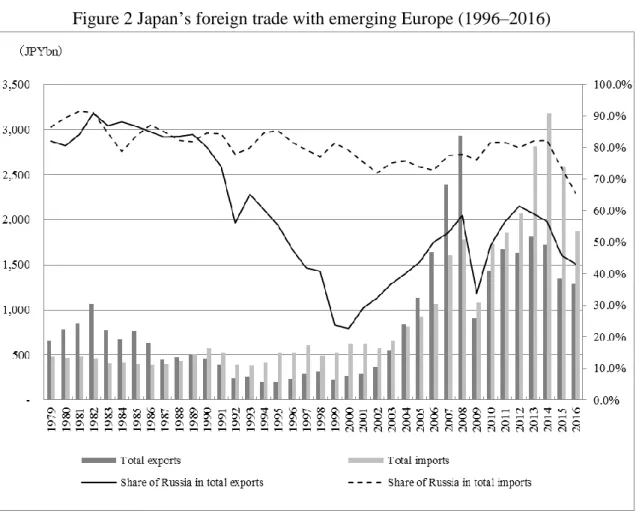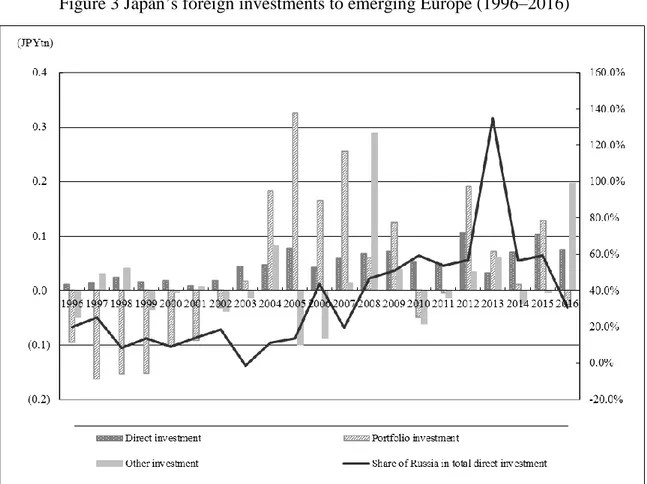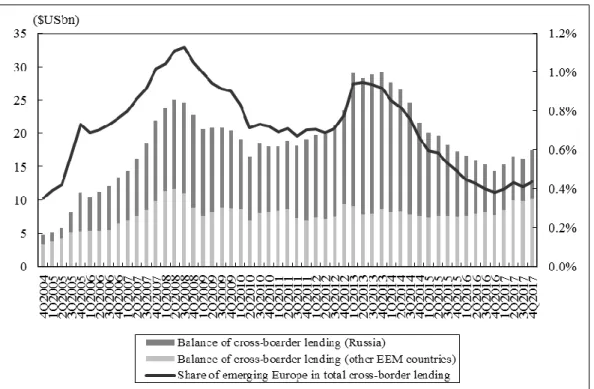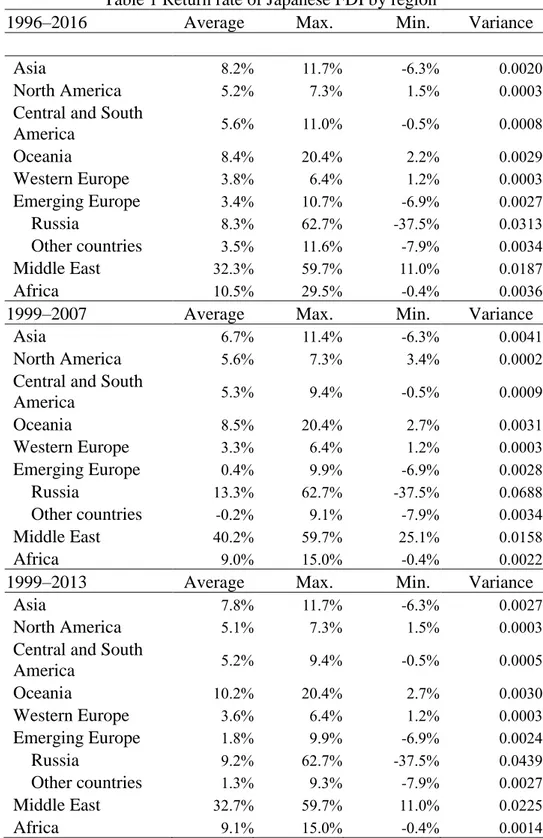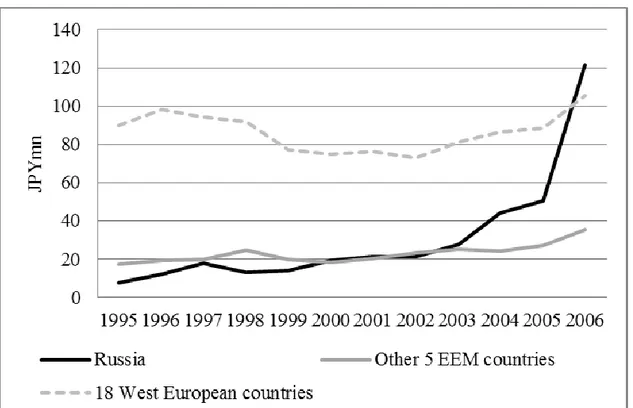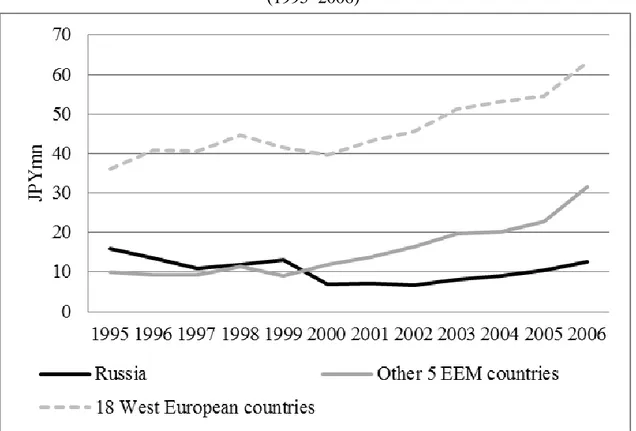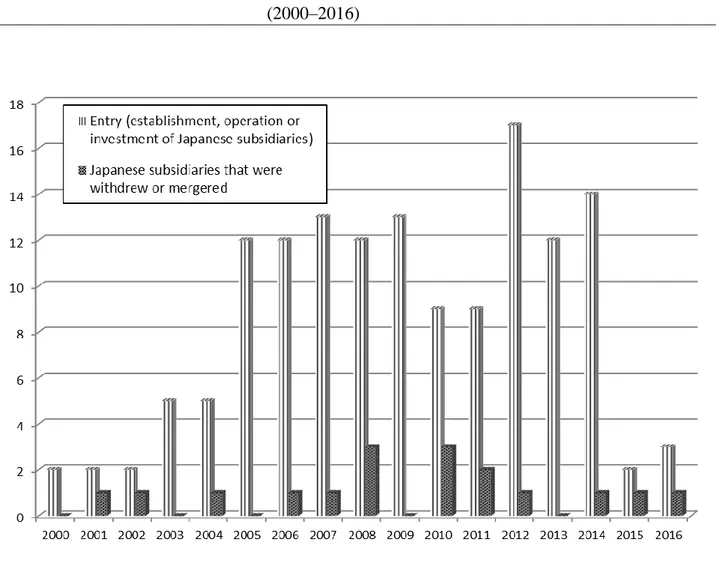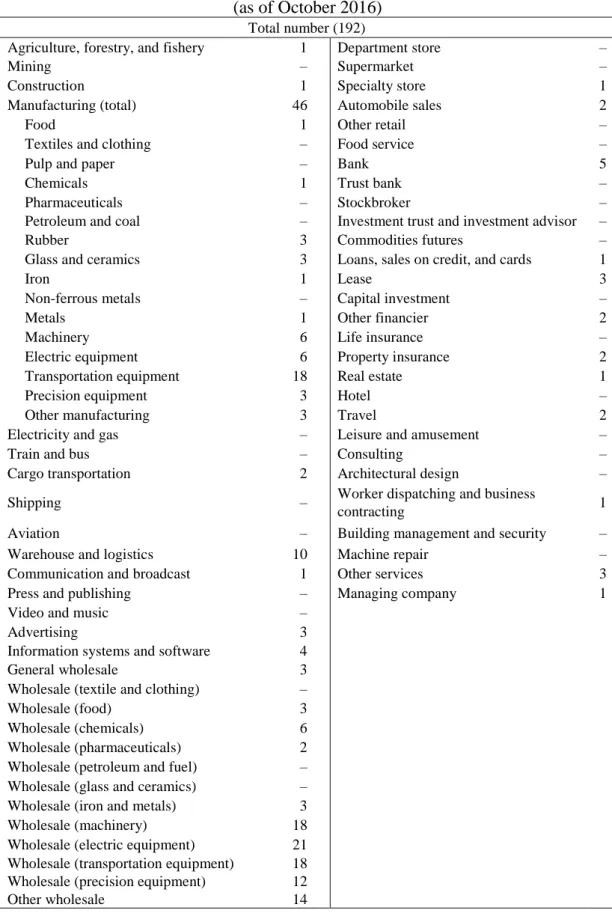From Russia to Eurasia: Specific Features of the Russosphere from the Perspective of Business Activities of Japanese Firms
著者 Tokunaga Masahiro, Suganuma Keiko, Odagiri Nami
journal or
publication title
RRC Working Paper Series
volume 77
page range 1‑57
year 2018‑06
URL http://hdl.handle.net/10112/16258
From Russia to Eurasia:
Specific Features of the “Russosphere” from the Perspective of Business Activities of Japanese Firms
Masahiro Tokunaga Keiko Suganuma Nami Odagiri
June 2018
RUSSIAN RESEARCH CENTER INSTITUTE OF ECONOMIC RESEARCH
HITOTSUBASHI UNIVERSITY Kunitachi, Tokyo, JAPAN
Центр Российских Исследований RRC Working Paper Series
No. 77
ISSN 1883-1656
1
From Russia to Eurasia: Specific Features of the
“Russosphere” from the Perspective of Business Activities of Japanese Firms
Masahiro Tokunaga,†a Keiko Suganuma,b and Nami Odagiric
a Faculty of Business and Commerce, Kansai University
b College of Bioresource Sciences, Nihon University
c Faculty of Foreign Language Studies, Kansai University
Abstract: In this paper, we demonstrate the trends and prospects of Japanese foreign direct investment (FDI) in European Emerging Markets (EEMs) against the background of the recent development of emerging markets and explore the specificities of the Russian market, the biggest EEM in terms of market size and inward FDI received. More specifically, we give an overview of foreign capital flows from Japan to major EEMs and describe the achievements and problems of Japanese investors as related to business with Russia. We find that the Russian market seems to be a lucrative option for Japanese firms, despite unfavorable investment conditions and limited institutional freedom afforded to outsiders, including a language barrier due to the wide usage of Russian in the business field. Although use of the Russian language is one of major business obstacles affecting foreign investors, making matters more challenging in the country, it nonetheless provides us with a common language as a hub of business operations in the former Soviet Union countries or “Russosphere,” where Russia has still economic leverage and maintains cultural domination.
JEL classification numbers: F2, P2, P3
Key words: foreign direct investment (FDI), European Emerging Markets (EEMs), business language, Russia, Russosphere
This research was financially supported by a Nihon University Research Subsidy (FY2014), the Kansai University Subsidy for Supporting Young Scholars (FY2015–16), the Joint Research Program of the Japan Arctic Research Network Center of Hokkaido University (FY2017), and a grant-in-aid for scientific research from the Ministry of Education, Culture, Sports, Science &
Technology of Japan (No. 17H04553: FY2017–19). We thank the participants to our questionnaire and interview survey and Tammy Bicket for her editorial assistance.
† Corresponding author: 3-3-35 Yamate-cho, Suita City, Osaka 564-8680, JAPAN; E-mail:
t030032@kansai-u.ac.jp
2 1. Introduction
Japan’s current account balance was radically changed in 2011, when it was forced to increase imports of fossil fuels because of an outage of all atomic power stations after the March 2011 Fukushima nuclear disaster. The goods trade balance fell to a deficit for the first time in 30 years, and the trade deficit was sustained until the mid-2010s. However, the Japanese economy was able to keep its current account surplus during this period, and it expanded in the first half of 2017 to its highest level since 2007, as earnings from foreign investments moved further into the black and offset a rise in energy prices that made imports more expensive (The Japan Times News, August 8, 2017).1 Although the size of Japan’s foreign direct investment (FDI) outflow and its overseas balance lags far behind other developed economies in terms of the ratio to the market size (GDP), the return rate of Japanese FDI has been increasing steadily since the beginning of the 1990s and is no lower than that of German FDI; therefore, the contribution of direct investment income received overseas to Japan’s balance of payments (current balance, income balance, and capital balance) has also risen during this period (Kumon 2013). In this process of change from a trading power to a major investment nation, the rapid growth of emerging market economies has an essential role to play in enhancing foreign investment activities (Tokunaga 2012a). Thus far, the European emerging markets (EEMs) have been one of the last newcomers for Japanese investors who accelerated overseas expansion after the full liberalization of inward and outward FDI in 1980 with a revision of the foreign exchange law.
In this paper, we demonstrate the trends and prospects of Japanese FDI in EEMs against the backdrop of the recent development of emerging markets and explore the specificities of the Russian market, the biggest EEM in terms of market size and inward FDI received. The remainder of the paper is organized as follows: Section 2 offers an overview of foreign capital flow from Japan to major EEMs and reveals that investing in EEMs is less profitable for Japanese investors than it is in other Asian and Latin American emerging markets, with the exception of Russia, which seems to be a lucrative option for them, despite the unfavorable investment conditions and limited institutional freedom afforded to outsiders. Section 3 describes the achievements and problems for Japanese firms associated with Russian business by analyzing both enterprise-level statistics and questionnaire surveys and semi-structured interview data collected from Japanese companies developing business in Russia. Section 4 gives attention to the relationship between business and language and explores how the Russian language is one of the major business obstacles for foreign investors, making matters more challenging in Russia, yet providing us with a common language as a hub of business operations in former Soviet Union (FSU) countries where Russia still has economic leverage and maintains cultural domination, more or less. The last section summarizes our major findings and concludes the paper.
1 See Nakamura (2017) for the recent trends of Japan’s current account balance.
3 2. Specific features of the Russian market for Japanese investors
2.1. Japanese foreign direct investment in European emerging markets
The economic development of EEMs2 associated with transition to a market economy is closely linked to the advance of Western multinational companies (MNCs). Not only has foreign direct investment encouraged structural reforms among local firms of host countries, but it has also contributed to new market expansion for and enhancements in the cost-competitiveness of foreign MNCs through the allocation of business resources in pan-European networks. In addition to FDI, portfolios and other investments have helped EEMs achieve rapid economic growth by boosting the consumer market in the 2000s. The Central and Eastern European area of EEMs was institutionally incorporated into Western-dominated economic rules through the EU accession process. In this way, EEMs went through so-called Europeanization (see Schimmelfennig and Sedelmeier 2005), and Europe acquired its own emerging market territory within its border: European MNCs have an economic advantage over their U.S. and Japanese rivals in this regard.
Although EEMs have received a great amount of foreign capital over the most recent two decades, Japanese firms are newcomers there. Despite a general awareness of large-scale production investments by a few big-name companies, Japanese FDI in EEMs had been comparatively slow, with an emphasis in the 1990s on the early establishment of sales subsidiaries (Inaba 2002; Marinov et al. 2003; Mizuho Research Institute 2006: 257–270).3 Only in the early 2000s did Japanese entities expand trade and investment relationships with EEMs, sparked by Toyota’s decision to build up local production systems in Poland, the Czech Republic, and Russia.4 Not only did Japanese FDI increase rapidly in the first half of the 2000s in anticipation of the EU accession of major EEM countries, but Eastern Europe also outperformed Western Europe as a destination of greenfield FDI from Japanese manufacturers (Ando 2006). When the global financial crisis of 2008–09 hit Japan harder than other major countries, Japanese firms sought to move their business operations and human resources overseas in order to exit a downturn in domestic demand.
A survey by the Development Bank of Japan (2010), for example, showed that large manufacturers
2 In this paper, EEMs refer to 17 Central and Eastern European countries and four Commonwealth of Independent State (CIS) member states (Russia, Ukraine, Belarus, and Moldova) located in the European part of the former Soviet Union. The Central and Eastern European countries consist of three Baltic states (Estonia, Latvia, and Lithuania), four Central European countries (i.e., the Visegrád Four: Hungary, Poland, the Czech Republic, and Slovakia), and the other 10 Southeastern European countries (Romania, Bulgaria, Slovenia, Croatia, Bosnia–Herzegovina, Serbia, Montenegro, Kosovo, Macedonia, and Albania), unless otherwise noted.
3 According to the classification of foreign subsidiaries by Benito et al. (2003), a sales subsidiary exemplifies a single-activity unit or a subsidiary with few value activities and a low level of competence. See also Eckert and Rossmeissl (2011) for an account of foreign subsidiaries in EEMs.
4 Toyota opened two engine manufacturing plants in Poland in 2002 and 2005, a joint assembly plant with the French Groupe PSA in the Czech Republic in 2005, and a semi-knockdown assembly plant in Russia in 2007. These were all greenfield investments.
4 emphasized capital spending in foreign markets with the purpose of boosting their business operations and responding to stable demand from emerging market countries.5 Thus, whether the actors involved will expand and deepen the economic relationship between Japan and Europe—a relationship that has long been overshadowed by Japan–U.S. and Japan–Asia relations—will depend on Japanese firms’ performance in EEMs.
In the late 1990s, Japan became the largest outward FDI investor in the world, overtaking European economic powers such as the U.K. and France. Roughly speaking, more than half of Japan’s total outward FDI was directed to North, Central, and South America; Europe and Asia each received less than 20% in the mid-1990s (Inaba 1999: 4–5). The Japanese economy, as the world’s second largest economic power after the U.S. economy and the largest capital supplier at that time, led us to study Japanese FDI dynamics, factors, impacts, and the like. In the context of Europe, including the former communist bloc countries, researchers have been concerned with the business contents and locations of Japanese MNC affiliates and have shown in great detail how they developed European business by using local resources and markets (e.g., Dicken et al. 1997;
Morita 1998; Schlunze 2001, 2006; Inaba 2002; Marinov et al. 2003; Ikemoto 2007; Koyama and Tomiyama 2007; Imai 2011). Japanese business scholars have also explored ways in which their country has entered local markets and transferred Japanese production management to Europe (Kumon and Abo 2004; Tomiyama 2004, 2011; Wada and Abo 2005; En 2006). Furthermore, a few economists have developed an empirical model by employing a Japanese FDI dataset in Europe (Head and Mayer 2004; Yoshida et. al 2009; Morita 2011).6 Referring to these research results and some basic economic statistics, let us start with an overview of Japanese FDI activities in EEMs.
A survey by Nikkei, Japan’s leading economic newspaper, has reported that the emerging market share of Japanese firms’ group-operating profits grew from 9% to 36% between 2000 and 2010 (Nikkei, December 16, 2010). They boosted their emerging market businesses in the process of recovering from the global financial crisis; this was much more necessary for Japan than for Western competitors, given the background of the Japanese yen’s historical appreciation, which affected export profitability and increased the effectiveness of foreign investment (Nikkei, July 23, 2011). Figure 1 reveals that the Japanese FDI balance has been increasing at close to the same pace as accumulated profits––a narrowly defined internal reserve, most of which would be appropriated to investment resources––of Japanese firms, meaning that they allocated accumulated capital surplus to overseas businesses after the late 1990s. With regard to the location of FDI balance by region, although its total doubled during the 2000s, its emerging market share increased from 26%
5 When interviewed by the Russian press, the president of Mitsubishi Motors said frankly,
“Japanese businesspersons do not want to invest in Japan” (citation from the headline of the interview in Vedomosti, Russia’s business press, September 12, 2011).
6 See also Head and Ries (2005) for a theoretical explanation of the large gap between Japan’s outward and inward FDI.
5 to more than 40% during this period. Asian and Latin American countries were the main targets, with other emerging markets such as Eastern Europe and Africa becoming foci of Japanese firms.
Figures 2 and 3 indicate that the Japanese economy has deepened the country’s trade and investment relationship with EEMs; however, their share of total trade and FDI balance remained at 2.9% (3.6% for exports and 2.3% for imports) and 0.65%, respectively—even when they reached the maximum value in 2008 for trade and in 2012 for investment.7 This relatively insignificant percentage is similarly reflected in the cross-border lending of Japanese financial institutions; the balance of cross-border lending on the basis of the final destination from Japan to the EEMs constituted no more than 1.1% of the total, even at its peak (see Figure 4). Therefore, all of these numbers derived from trade, investment, and financial statistics tell us that EEMs still remain a minor business space for Japanese MNCs.
Note that these figures are likely to be underestimated because of the untraceability of goods and capital flows outside the home country, such as intra-firm trade among foreign subsidiaries and capital spending by regional headquarters. For instance, Asahi Glass, Japan’s leading glass producer, has invested in several float glass furnaces in Russia through its Belgian subsidiary Glaverbel (press release by Asahi Glass on March 22, 2007), and a major consumer electronics maker had long developed Russian business under the control of its Finnish subsidiary before establishing a Russian subsidiary in 2008 (from our interview with the Vice President of the company, Moscow, February 13, 2012). The Japanese bank sector widely uses their European branches located in Germany and the Netherlands to enlarge their financial operations in Russia (Gorshkov 2017). The Netherlands seems to be an investment hub in Europe for Japanese investors in general: a medical equipment supplier has been involved in their Russian business, which has been financed by the regional headquarters established in Amsterdam (from our interview with an executive director of this company, Kyoto, March 8, 2018). Quite interestingly, Japanese investors take a stake in one of the biggest investment opportunities in EEMs, Sakhalin oil and gas development project in the offshore fields northeast of Sakhalin Island in the Far East of Russia, less than 30 miles north of Hokkaido (the most northerly prefecture of Japan), likewise via the Netherlands (Endo 2007) with Sakhalin Energy Investment Company, an operator of the Sakhalin-2 project, that was incorporated in a self-governing British overseas territory, Bermuda (Takahashi 2010). This scheme does not seem to be limited to the Sakhalin Project; data from the Bank of Japan tells us that almost a quarter of Japan’s total FDI balance of the mining sector is found in Europe, the Netherlands (15.1%), and the U.K. (9.5%), among others, much of which is likely to go toward a resource-rich land such as the post-Soviet area (Russia, Azerbaijan, Kazakhstan) and the Middle East region (United Arab Emirates etc.), where only a limited amount of the FDI balance of
7 These are our calculations, based on data from the Bank of Japan (various years) and Japan’s Ministry of Finance (2018a).
6 the mining sector is being recorded (just 0.4% of the total). Japan’s Ministry of Finance (2016) reported that the Netherlands is now the third largest recipient of Japanese FDI, trailing only the U.S. and China, where the mining sector accounts for more than 10% of the total direct investment balance. This is specific only to this country among the major lightly taxed countries.8
According to local tax lawyers, the Netherlands has two main advantages for both domestic and foreign companies (from our interview with two Dutch tax lawyers, in Rotterdam and Amsterdam, on March 6 and 7, 2015). First, it has a pretty attractive tax scheme, often called “tax participation exemption.” The Dutch participation exemption has been one of the cornerstones of Dutch corporation tax law; it provides for an exemption for dividends and capital gains on qualifying participation (Janssen and Kiès 2015). This system enables Japanese investors to enjoy lower taxation on dividends to parent companies via the intermediary Dutch holding companies, as compared to direct distribution from oversea affiliates to parent companies in Japan (Hemels 2010).
In a simplified description, whereas Russian affiliates are subject to a 15% tax on dividends to their headquarters in Japan, this tax rate could be reduced to 5% if they are financed via Dutch companies, thanks to privileges and immunities stipulated in the tax treaty between the Netherlands and Russia (Itoi 2018). Second, its bilateral tax treaty network with many European countries gives any business entities established in the Netherlands an opportunity to use this institutional asset, even if the home country does not negotiate a tax treaty with the host country. Take Japan and Russia—each has had a tax treaty with the Netherlands—as examples; they seem to operate with a de facto bilateral tax treaty in a contemporary style and reduce the risk of international double taxation.9 Relying on this scheme, available from a worldwide tax treaty network, Dutch companies with affiliates in a third country (Russia, etc.) are able to distribute all dividends from Russia or any other country to Japan without any taxation, since this is set down in a bilateral tax treaty signed by the Japanese and Dutch governments in August 2010.
Moving back to the topic of FDI performance, Japanese manufacturers rushed into Hungary, Poland, and the Czech Republic from the end of the 1990s and reorganized their European production networks through the 2000s. As of the beginning of 2001, they considered these countries as the three most attractive investment destinations in all of Europe, thus revealing their expectations vis-à-vis the core region of EEMs becoming a “European factory” (Nikkei,
8 Although the Netherlands is not a tax haven in the usual sense, it is true that energy-sector FDI from the country sometimes corresponds to unknown investment activities by Dutch companies in Russia (Hanson 2010).
9 The Japanese government signed a tax treaty with the Soviet Union in January 1986, and it went into effect in November of that year. It is easily understandable that this old scheme did not fit with the progress in marketization of modern business operations in Russia. Therefore, both countries agreed to conclude a new tax treaty based on the OECD Model Tax Convention and signed it in September 2017. It is expected to enter into force in 2019 after legislative ratifications in both countries (for more details, see Itoi 2018).
7 November 29, 2001). The local production of transportation equipment and electrical machinery, including ICT equipment, has expanded there, mainly in the form of greenfield FDI; the transfer of Japanese production systems––one of the main strengths of Japanese manufacturers in organizing superior product management––has succeeded thus far without serious troubles (En 2006).10 Large-scale production investments by Toyota, Suzuki, Panasonic, and the like have accelerated Japanese FDI in EEMs.11 Through the end of 2010, Japanese manufacturers had established 1,108 production facilities in all of Europe, including Turkey, of which 274 are located in Central and Eastern European countries and Turkey: by country, the Czech Republic and Poland were ranked fourth and fifth, above Italy and Spain (JETRO 2012: 2). In this way, some EEM countries steadily secured a foothold as a “European factory” by being incorporated into pan-European production networks.
2.2. Is Russia Different?
Many empirical works have indicated that EU accession proposals and the subsequent negotiation process have a positive influence on FDI for future member states by improving their investment environment (see Bevan and Estrin 2004; Clausing and Dorobantu 2005; Fabry and Zeghni 2006;
Iwasaki and Suganuma 2009; PricewaterhouseCoopers 2010; Deichmann 2013; Derado 2013).12 A meta-analysis of the determinants of FDI in Central and Eastern and FSU countries has shown that institutional integration with Western Europe has a genuine FDI promotion effect for new EU member states (Tokunaga and Iwasaki 2017). This would be relevant for Japanese firms, as Morita (2011) infers a priori. However, Table 1 shows that Japanese firms’ FDI performance in EEMs is poor in terms of profitability, despite the fact that the return rate of direct investment in emerging markets is generally much higher than that in developed markets. What needs to be made clear is that improvements in the business environment do not always translate into a higher return on investment. The reasons for this are not difficult to see.
First, the combined shares of the service, real estate, and finance and insurance sectors––
highly profitable industries compared to others––were no more than 10% of the total Japanese FDI balance in EEMs as of the end of 2010 (Bank of Japan 2011), thus, reflecting the competitive dominance of EU-based enterprises in these fields.13 Second, according to the Japan External
10 However, this has been identified as the cause of low profitability among Japanese MNCs. Refer to Urata (1998) and Itagaki (2002) for further discussion.
11 See Marinov et al. (2003), Ikemoto (2007), and Koyama and Tomiyama (2007) for the investment profiles and management strategies of each company.
12 Concurrently, Iwasaki and Suganuma (2009) found that EU member country candidates experienced an adverse impact on FDI in the final phase of the negotiation, given the substantial revision of conventional FDI incentives—which was most likely the price paid for becoming new EU members. An empirical study of regional FDI distribution in Poland supports the view that EU accession had a nonlinear effect on FDI decision making in the country (see Chidlow et al. 2009).
13 In the 2000s, the main targets of world investors toward EEMs were financial sectors; they
8 Trade Organization (JETRO 2012: 27), 67.4% of the total sales of Japanese manufacturers located in Central and Eastern Europe were gained in Western Europe, where the FDI performance of Japanese firms has been lowest vis-à-vis the return rate of direct investment abroad in the advanced economies (see Table 1).14 This means that even if Japanese MNCs are deploying their own business resources in EEMs, they are, in fact, competing with Western rivals in mature European markets. In other words, EEMs are facing an economic dilemma wherein the more they strengthen their ties with Western Europe, the more significantly they lose the characteristics of emerging markets.
Concurrently, the same FDI statistics reveal two significant characteristics with respect to Japanese FDI in Russia, one of the largest EEM markets. First, from the mid-2000s onward, Japanese direct investment in Russia has accounted for 50–60% of the total direct investment in EEMs, with a few exceptions (see Figure 3).15 The country is now the largest EEM investment destination for Japan’s business society. Second, and more importantly, while Russia received a modest proportion of Japanese FDI as compared to other emerging markets, such as China, it witnessed a much higher investment return in the European market. As shown in Table 1, the annual return rate of direct investment in Russia was more than 13% for 1999–2007, when the country recorded remarkably rapid growth due to the rise in the price of oil; it had remained at almost 9%, or up to 7 times higher, against other EEMs through 2013, the year when Russia’s oil-price-hike-lead growth model faced falling oil prices and economic sanctions related to the Ukrainian crisis (Tabata 2016). A t-test for the average difference in the annual return rate of direct investment indicated that its average for Russia is statistically different from those for other EEM countries at the 10% level for both periods of 1999–2007 (t = 1.509, p = 0.083) and 1999–2013 (t = 1.405, p = 0.090). This picture is endorsed by Russia’s higher labor productivity (sales per employee) as compared to that of five other EEM countries (Czech Republic, Slovakia, Hungary, Poland, and Romania) in the mid-2000s, as Figure 5 clearly demonstrates.16 These investment performance parameters are, as a rule, obviously linked by way of realizing business profits.
Direct investments by Japanese manufacturers in Russia are highly oriented toward the car industry and show a lack of business diversity: the business profiles of non-manufacturing accounted for approximately 40% of the total FDI balance in 2010 (wiiw 2011). More than 60% of banking assets in the new EU member states were held by foreign subsidiaries at that time (European Central Bank 2010: 20–21).
14 Kumon (2013) also reports that Japanese firms’ profit rates are generally low in the EU market.
15 Russia’s share exceeded 100% in 2013 because of the negative direct investment performance or withdrawal of oversea capital from other EEM countries.
16 Figure 5 was compiled from an outward FDI database that was specifically established by the Research Institute of Economy, Trade and Industry (RIETI), Japan to eliminate errors and biases associated with revision of the Survey on Overseas Business Activities of Japanese Enterprises released annually by the Ministry of Economy, Trade and Industry of Japan (see the next section for its outline). As for recent trends in Japanese FDI by region, see Masuda (2008) and Iwami (2009).
9 sectors that have advanced into Russia are also closely related to the car industry, such as car sales, car loans, and auto insurance. Although the number of Russian affiliates of Japanese firms directly related to the car industry remains at around 20% of the total,17 this industry has a broader business base and constitutes the majority of Japanese–Russian business.18 This is reflected in the Japan-to-Russia export profile: motor vehicles (including car parts) constituted 77.2% of exports at its peak in 2008, in contrast to 2.5% in 1988.19 Japan’s exports of automobiles to Russia highly contributed to the boom in trade between the two countries in the 2000s, together with an eastward shift in the Russian economy as being reflected in its increasing exports of oil and gas to Japan (Tabata 2013).
What must be noted here is that the majority of Japanese manufacturing factories in Russia are also associated with the automobile industry; only a few companies are operating lumber mills, food-processing plants, or heavy-equipment production factories. More importantly, the electric machinery industry—another big FDI player next to the automobile industry—has only built a limited number of assembly plants in Russia to date. In this respect, the country is quite different from other emerging-market economies such as China and the ASEAN countries (Tokunaga 2011; Nakai 2017). To quote a former director of the Russian subsidiary of the above-mentioned Japanese consumer electronics maker (see p. 5): “While the electric machinery industry, in general, needs a government policy of support for large business investments regardless of whether they are domestic or foreign––obviously the Russian government lacks such a strategy–
–the Russian market is far sweeter than any other for Japanese export-oriented industries” (from our interview with the director of the Moscow office of the Japan Center, April 1, 2010). Other managers of Russian affiliates of Japanese firms and consultancies agree that the Russian economy is much less competitive for developing local production networks and common production processes consolidated with neighboring countries than are the East Asian countries to which Japanese FDI rushed in the first stage of globalization. Figures 6 and 7 support this view: the labor productivity of Japanese manufacturers in Russia remained well below that in Western Europe, with a widening gap with other EEM countries in Eastern Europe; in contrast in non-manufacturing sectors, their labor productivity increased rapidly in Russia, outperforming their counterparts in other European markets.20
In brief, the FDI performance of Japanese MNCs suggests that the Russian market has thus far provided Japanese firms with a limited capacity for business activities, and yet it offers
17 This figure is calculated based on a dataset of overseas affiliates of Japanese companies provided by Toyo Keizai (2017). We will touch on this issue again in the next section.
18 Refer to Tokunaga (2011; 2012b) for further discussion.
19 These are our calculations from Japan’s trade statistics provided by Japan’s Ministry of Finance (2018).
20 Using the original dataset of the Survey on Overseas Business Activities of Japanese Enterprises, we confirmed that this trend was continued until 2009.
10 quite lucrative business opportunities as compared to other EEMs. The economic attractiveness of Russia as an emerging market is supported by enterprise-level survey data. According to the results of an annual questionnaire survey on overseas business activities among Japanese manufacturing companies conducted by the Japan Bank for International Cooperation (JBIC), they earned much higher profits than expected, i.e., higher “unexpected” profits in Russia than in any other part of the world, putting Russia in first place in terms of profitability, at least prior to the global financial crisis (JBIC 2008: 25).21 Even during and after the crisis, Russia seemed not to have lost its attractiveness as a sales market for the European affiliates of Japanese firms: JETRO’s annual reports on Japanese affiliates in Europe demonstrate that the country ranked first or second from 2007 through 2014 in terms of future sales destinations in Europe (JETRO 2017a: 32).
3. Achievements and problems of Russian business for Japanese firms
As we pointed out in the previous section, the inflow of foreign capital into Russia from foreign investors, including Japanese firms, has increased since the mid-2000s, and Russia currently enjoys the largest amount of foreign capital among EEMs. On the other hand, it was revealed that the Russian market has characteristics different from those of other EEMs, in that, for example, the return rate of Japanese FDI there is as high as that in Asian markets (see Table 1). In this section, after outlining the business expansion of Japanese firms into the Russian market, which has characteristics different from those of other EEMs, we will look at the problems that Japanese firms face and how they are dealing with those problems.
First, we outline trends concerning Japanese firms’ entry into and withdrawal from Russia.
According to the Annual Report of Statistics on Japanese Nationals Overseas, published by the Ministry of Foreign Affairs of Japan, there are 450 of Japanese firms based in Russia as of October 1, 2016; this figure is the 19th largest for individual countries where they operate. The breakdown is: 250 subsidiaries, 161 representative offices, 11 branches, and 28 unclassified bases (Ministry of Foreign Affairs of Japan 2017). It has been confirmed that more than half (55.6%) of these bases are subsidiaries.
As described above, the expansion of firms into foreign countries can be roughly divided into three forms of bases: (1) subsidiaries, (2) branches, and (3) representative offices. As a matter of course, however, these three forms of bases vary widely, from a legislative point of view, in their activities and obligations,22 thus, the Japanese parent firms strategically choose the form of entry after considering this point. For example, because a representative office is not permitted to conduct commercial activities, Japanese firms must choose the form of a branch or a subsidiary if
21 Note that JBIC asked the surveyed enterprises to answer a question about their subjective evaluation of profitability in overseas markets––that is, to what extent profits earned were larger or smaller than planned––rather than their actual increase or decrease.
22 The differences in conditions by form are detailed in Matsushima (2017) and JETRO (2015).
11 they plan to conduct commercial activities. However, because the activities of a branch office are more limited regarding imports and customs clearance than are those of a subsidiary, Japanese firms must choose the form of a subsidiary if they want to fully conduct their business activities.
Related to this issue, some Japanese firms have changed their form of base from a representative office to a subsidiary in recent years, and other Japanese firms maintain both a representative office and a subsidiary (JETRO 2015; and from our interviews with the managers of Japanese subsidiaries in Russia). As described in an earlier section, Japanese firms’ headquarters can directly invest in their bases in Russia, invest through their regional headquarters in Europe, or jointly invest with their regional headquarters in Europe. It has been pointed out that Japanese firms often decide through which country they invest in their subsidiaries in Russia by taking into consideration the development division of each firm and the preferential treatment conditions of taxation between the registration country of the investing firm and Russia (Matsushima 2017).
Among all sources that reveal trends of advancement overseas of Japanese MNCs, statistics from the Ministry of Foreign Affairs seem to be the best for determining the number of foreign bases.23 However, these statistics only reveal the total number of bases, the breakdown of the forms of these bases, and the breakdown of all bases by industry and by diplomatic establishment (embassy, consulate general, etc.). From the data, it is impossible to know the breakdown of subsidiaries occupying a major part of the bases by industry, the withdrawal trend of Japanese firms from the Russian market, and so on. On the other hand, Japan’s Ministry of Economy, Trade and Industry reports on the situation of overseas activities of Japanese firms in the Survey on Overseas Business Activities of Japanese Enterprises.24 This data has the advantage of making it possible to know the number of subsidiaries by country and the breakdown of subsidiaries by industry; however, it has the disadvantage of a low capture rate. Therefore, we outline the recent situation of Japanese subsidiaries in Russia, based on the Toyo Keizai’s data, from which it is possible to identify trends of entry and withdrawal of Japanese firms, although its capture rate is not as high as the data from the Ministry of Foreign Affairs.
The number of entries (establishment, operation, or investment of subsidiaries) of Japanese firms into Russia started to grow in 2003 and sharply increased in 2005 but dropped in 2015 (see Figure 8). It has been pointed out that the accelerated entry of Japanese firms into Russia in 2005 was greatly influenced by the entry of Toyota in the manufacturing area (Nakai 2017;
23 As for the trends of Japanese firms expanding into Russia, the information possessed by the Japan Association for Trade with Russia & NIS (ROTOBO), a research institute specializing in Russia and New Independent States (NIS), has the highest capture rate; unfortunately, it is not accessible to the public. Using its own database, the Manager of the Research Department, Institute for Russian & NIS Economic Studies, ROTOBO, demonstrates the long-term trends of the establishment of Japanese subsidiaries in Russia (Nakai 2017).
24 For details, see Japan’s Ministry of Economy, Trade and Industry (2017).
12 Umetsu 2017: 114; and from our interview survey in Russia).25 On the other hand, it can be said that the sharp decrease in the number of entries in 2015 was due significantly to the 2014 Ukrainian crisis and the depreciation of the Russian ruble. Meanwhile, between 2000 and 2016, an average of one company per year was withdrawn or merged. As a result, according to Toyo Keizai (2017), as of October 2016, 192 Japanese subsidiaries were operating in Russia (see Table 2). In view of the breakdown of these subsidiaries by industry, there are more non-manufacturing industries (146) than manufacturing industries (46), accounting for three-quarters of all Japanese subsidiaries. A more-detailed breakdown shows that the most subsidiaries by industry type are, in descending order: “wholesale of electric equipment” (21) and “manufacturing of transportation equipment,”
“wholesale of machinery,” and “wholesale of transportation equipment” (18 for each). In this data, industry types are subdivided particularly finely for the service industry, and the total number of wholesalers is just 100, accounting for about half (52%) of all Japanese subsidiaries. It is possible to consider that these wholesalers function as sales companies for “machinery and transportation equipment,” which accounted for approximately 80% of Japanese exports to Russia in 2016, and for the 30 manufacturing sector entities (in machinery, electric equipment, and transportation equipment) in Russia. In addition, as we pointed out in the previous section, Japanese firms related to transportation equipment comprise about 20% of the total subsidiaries in the country.26
Next, we will present the business environment in Russia, which can affect the business expansion of Japanese firms into Russia, and compare it internationally. According to Doing Business, a well-known international index on business environments by country published by the World Bank, the business environment in Russia has improved significantly. For example, Russia’s 2010 rank in “ease of doing business” was 123rd of 183 countries, while it was 35th of 190 in 2017, improving within a short time span. Among the ten items in the overall determination criteria, Russia’s rankings in “starting a business,” “dealing with construction permits,” “getting electricity,”
“getting credit,” “paying taxes,” and “trading across borders” climbed by 50 or more during the same time span, and those of the other items also improved; items for which Russia previously had
25 Toyota established a manufacturing plant in Saint Petersburg in 2005 and started production at the end of 2007 (from Toyota’s website: Establishment of TMMR,
http://www.toyota.co.jp/jpn/company/history/75years/text/leaping_forward_as_a_global_corporatio n/chapter4/section2/item3_c.html).
26 The total number of companies in “manufacturing of transportation equipment,” “automobile sales,” and “wholesale of transportation equipment” is 38, accounting for 19.8% of all companies (see Table 2). Several other companies such as those in “manufacturing of rubber,” which focus on the production of car tires, can also be regarded as related to transportation equipment. The automobile industry is very extensive and influential, involving not only material manufacturers but also sales, service, and the finance industry. It is also known that Japanese automakers call for the entry of their affiliated car parts manufacturers when they expand their business operation overseas.
Besides, some Japanese automakers have their own financial institutions engaged in car loans, etc., such as Toyota Bank (Gorshkov 2015).
13 a relatively high ranking remained at the same level (see Table 3). However, as also described later, corruption has been considered to be a serious problem in Russia and still remains unsolvable. In fact, Russia was ranked 154th of 178 countries in 2010 in the Corruption Perceptions Index, constructed by Transparency International, an international organization renowned for its anti-corruption campaign; it was 135th of 180 countries in 2017, which shows that it has not improved as much as Russia’s business environment rankings.27
Thus far, we have reviewed international organizations’ assessments of Russia’s business environment. How, then, does the business environment in Russia look to Japanese firms operating in Russia? In addition, how do these Japanese firms respond to issues stemming from Russia’s particular business environment? We will examine this point based on various survey results from JETRO, a government-sponsored organization that works to promote mutual trade and investment between Japan and the rest of the world, the Japan Business Council for Trade and Investment Facilitation (JBCTIF), and our interviews with managers of Japanese subsidiaries in Russia.
As described above, the number of Japanese firms entering into Russia dropped in 2015, while almost half (49.5%) of Japanese firms (excluding representative offices) already operating in Russia expected a surplus in operating profits in the same year (JETRO 2016). According to the same survey in 2017, the percentage of Japanese firms expecting a surplus increased to 66.3%
(JETRO 2017b). It seems that business conditions are not so deteriorated by any means. However, Japanese firms have hardly expanded into Russia in recent years, which could be caused or affected by the business problems that Japanese firms actually face in Russia and the bad image of Russia that their parent firms have, in general.
In 2017, Japanese firms ranked “market size/growth potential” as the biggest advantage of the investment environment in Russia, while the following problems rank high as risks: (1) volatility of exchange rates, (2) complex administrative procedures (permission and licenses, etc.), (3) complex tax system and procedures, (4) unstable political and social climates, and (5) inadequate and unclear legal system.28 Japanese firms consider the following more problematic, regarding the management challenges associated with the risks above: fluctuations in the exchange rate of local currency against the dollar/euro, complex procedures for customs clearance, and increases in the wages of employees. The percentage of respondents who chose those items above exceeded 50% because multiple answers were allowed (JETRO 2017b). What sorts of problems do the factors listed above cause? Regarding the exchange rate, it has been mentioned that auto parts that depend on imports are so affected by exchange rate fluctuations that profitability cannot be
27 Note that the corruption ranking denotes that the higher a country is ranked, the lower the Corruption Perceptions Index (or the smaller the number of corruption cases).
28 As compared to results from the same survey in 2015, however, the percentage of respondents who chose these risk items declined. It can be said that these risks have become less influential in the past few years (JETRO 2016; 2017b).
14 ensured. Complex procedures not only mandate many required documents, but the responses often differ from contact to contact, giving rise to a need for confirmation in each case. It has also been pointed out that the time frames from receiving notice to the implementation of frequently changed laws and regulations are relatively short, and specific guidance is not provided to the contact person in charge; therefore, it is often the case that on-the-spot responses are impossible. In addition to many required documents and procedures, in principle, they are to be in Russian, which is time-consuming paperwork for foreign entities that increases operational costs (JBCTIF 2017).
Russia’s economic institutions differ from those of Japan in many important ways, including their accounting systems and tax bases,29 so that more staff members (especially accounting experts) are needed than in other countries to respond to these differences. That leads to a sharp rise in labor costs (JBCTIF 2017; Matsushima 2017; and from our interview survey). Japanese firms often face other challenges associated with the Russian government’s policies. For example, the following policies are considered to be quite problematic: (1) import tariffs are higher than those in other countries and abruptly raised; (2) the competitiveness of foreign manufactures is lower than that of domestic entities, due to the recent introduction of the “recycling tax (vehicle disposal tax)”30; (3) the federal government’s policies, including the high import tariffs above, do not conform to WTO rules; (4) foreign companies operating in Russia are treated differently; (5) because personal data on Russians must be stored within the country, companies must set up data centers in Russia; and (6) it is difficult to protect intellectual property rights or patent rights (JBCTIF 2017).31
In addition to the questionnaire surveys carried out by the Japanese side of the organization, a research team from the Russian side conducted a similar survey. According to the latter, Japanese firms’ major business challenges in Russia are: (1) language, (2) laws and regulations and procedures for clearing customs, and (3) taxes. In interviews by the researcher in
29 The tax systems, accounting systems, certification systems, labor systems, etc. in Russia are detailed in Matsushima (2017) and Umetsu (2017). Differences in the accounting systems of Japan and Russia can be found in Matsushima (2017).
30 In Russia, a vehicle disposal tax on both new and used imported or domestically produced vehicles by weight and type (cars, buses, trucks, etc.) was introduced on September 1, 2012. At first, those meeting certain conditions, including being produced in Russia under the framework of
“industrial assembly steps,” were exempted from the tax. However, when the law was revised as of January 1, 2014, domestic products that had been exempted from this tax scheme were subject to taxation under the same conditions as imports (from JETRO’s trade bulletin, October 24, 2013:
https://www.jetro.go.jp/biznews/2013/10/5268825412110.html). In spite of the law’s revision, however, it has been pointed out that domestic manufacturers are virtually compensated in a form unrelated to the recycling tax; foreign manufacturers can also be exempted from the recycling tax, although the exemption criteria are, in effect, too strict to be met (JBCTIF 2017). It is often been said that this tax regime could force foreign automakers in a disadvantageous position (See, for example, Vedomosti, March 7, 2018).
31 One of the authors (Suganuma) also frequently heard about these challenges in interviews with the managers of Japanese subsidiaries in Russia, which were conducted from 2015 to 2017.
15 charge of the Japanese firms in this survey, it was pointed out that labor resource management is a major challenge (Ershova 2017). The language issue is also described by Rebrei (2014: chapter 3;
2015) and Gorshkov (2015).
Although it is more or less true even for other emerging/developing countries, Russia’s economic systems and specific circumstances are different. These systemic divergences vary widely.
For example, in terms of labor management, employment in Russia is, in principle, of unlimited duration, and employers are responsible for all social security costs. It is possible to consider that this is caused or affected in some way by their historical experience with socialism and systemic transformation, cultural differences, etc. Japanese firms in Russia are unavoidably forced to respond with flexibility to circumstances different from those they would encounter in their home country. Japanese firms in Russia often respond to the many complex document preparation requirements and procedures by relying on manpower. In some cases, they directly ask the authorities concerned or local governments to make improvements in their seemingly unreasonable system or the operation of the system. In addition to responding to these challenges, companies face the usual task of making a profit by developing markets and through other means. In doing so, negotiations in Russian are naturally required and important. Japanese firms in Russia seem to take the following four measures to smoothly launch these negotiations: (1) asking for Russian staff with English skills, (2) stationing Japanese staff who can speak Russian (Japanese expatriates and/or locally hired Japanese employees), (3) hiring Russian staff who can speak Japanese, and (4) utilizing local companies (see Table 4). For companies that require transactions with the Russian authorities, companies, and individuals, measure (2) or (3) seems to be used most often. Many other companies focus on measure (1). In this case, Japanese expatriates and local staff communicate in English in the office, and the local staff negotiates with local counterparts and performs the procedures in Russian. Some Japanese firms engaging in sales, etc., take measure (4) and utilize Russian distributors to develop local markets. In addition to utilizing local distributors, some collaborate with local companies, and others hire local staff with knowledge and experience in their relevant business field. However, it is difficult to capture highly professional and quality job seekers in Russia (Umetsu, 2017); thus, some Japanese firms in Russia offer high salaries to headhunt such human resources from other companies.32
The facts mentioned above confirm that the entry of Japanese firms into the Russian market accelerated in 2005 but slumped in 2015 under the influence of economic sanctions after the 2014 Crimean crisis and the depreciation of the ruble along with a collapse in oil prices. On the
32 One of the authors (Suganuma) heard in interviews in Russia that Japanese firms headhunt employees from other foreign rivals or Russian companies rather than Japanese competitors.
Furthermore, a quantitative analytical study on human resource management measures in Russia confirmed that a high salary level can improve the motivation of Russian workers, and merit-based promotion can improve the motivation of Russian managers in particular (Fey et al. 2000).
16 other hand, it was found that Japanese firms already operating in Russia face various problems in a country with a markedly different historical background and culture, despite a geographical vicinity of two countries. Although concrete solutions to these problems seem to vary naturally for each individual company, the language is a common problem for Japanese firms doing business in Russia. To solve the language issue, Japanese firms in Russia take measures appropriate for their own situation. The former republics of the Soviet Union, which at one time formed a single country with Russia, each has its own language designated as the state language; after the systemic transformation, language issues seem to be more complicated than in Russia. In fact, the FSU countries, which are now independent states with sovereignty rights, may be seen, nonetheless, as a greater Russian-speaking sphere, where it is possible for many people to communicate with one another and make various documents and publications in Russian as well as in their new state languages. In the next section, therefore, we will consider the potential of the Russian-speaking sphere in the context of business and market.
4. An essay on the Russosphere market
4.1. Business and language: Russian as a business language
Thus far, we have discussed the issue of specific features of the Russian market for Japanese investors and how they attempt to solve the various problems there. It seems that one major business obstacle to overcome is a language barrier in Russia, as was suggested in the previous section. While language issues have been relatively ignored in the literature of business and economics, foreign investors are often faced with challenges due to business culture differences as well as language differences (Welch et al. 2005). The following is an extreme case encountered by a Danish businessperson in his management operations in Latvia, one EEM still closely tied to the Russian-speaking community because of the solicitousness of the mass media and educational institutions to the situation of Russian speakers in the wake of Latvia’s postwar history as a part of the Soviet Union (Komori 2017).33
“We were exposed to five languages every day.…The official language of the authorities was Latvian, and 273 of the work force and the local managing director spoke Russian only. English
33 The last national population census under the Soviet Union showed that 42.1% of Latvian residents spoke Russian as their first language and another 39.1% was fluent in Russian as a foreign language at the end of the 1980s (our calculations from the results of the USSR 1989 census, Statistical Committee of the Commonwealth of Independent States 1993: 536–537). As of October 2014, Russian was spoken by approximately 30% of the population, mainly Russian immigrants who live in the urban areas of the country (from the website of the BBC: Languages across Europe, Latvia, http://www.bbc.co.uk/languages/european_languages/countries/latvia.shtml). See also Table 6 shown later.
17 was so to speak our working tool….With some of the older employees and with our German suppliers we communicated in German,…and amongst ourselves [the Danish expatriates], we obviously spoke Danish. The daily exposure to that many very different languages tends to keep one[’]s linguistic ability on its toes, but the constant need for translation is of course very time consuming.” (citation from Jacobsen and Meyer 1998: 11).
Language challenges in the Russian cultural and/or historical sphere, or Russosphere,34 can create such a demanding situation for Western investors that Russian language skills are widely seen as an essential qualification for expatriate managers based in Russia in order to communicate with a variety of stakeholders (Jacobsen and Meyer 1998). Our original questionnaire survey on the usage of Russian for Japanese businesspeople with experience in doing business in Russia and/or other FSU countries more or less supports the view that Russian language skills are an essential element for streamlining the business operations of Japanese firms in the Russosphere.35 This argument is supported by the fact that a working language between Japan’s business society and their counterparts from major CIS member states other than Russia is still the Russian language;
according to the website of ROTOBO (2018), there were 64 various business networking events for encouraging commercial relations with these countries, in which it has been more or less involved from 2008 to date, where they talked through Japanese-Russian interpreters in 51 cases among those events with their working languages specified in the fliers or programs (54 cases in total).36 Although business opportunities are still fairly limited there, with the exception of Russia, as is suggested in Table 5, we also found that the number of business entities and persons has been rising steadily in other CIS countries in recent years.37 Even now, the private sector is, in general, fragile there; thus, it seems difficult, if not impossible, for many Japanese investors to make purely private transactions without receiving public assistance (JETRO 2018). Nonetheless, local markets with much younger cohorts are expected to develop rapidly in the future and, unlike Russia, with which Japan has been involved in an intractable territorial dispute for more than half a century, no
34 A few other terms give expression to the community of Russian speakers such as Russophone (Ponarin 2000), Russophonia (Saunders 2014), and Russophonie (Usuyama 2014). In this paper, we use Russosphere, following the precedent set by Kotkin (2011), which describes a link that, as expressed by a shared language, history, and culture, is fundamental to contemporary world economic and political geography.
35 Unless otherwise noted, the descriptions in this paragraph and the next two are based on information obtained from this survey, which is still being conducted when this paper was being written. We will report on the full results at another opportunity.
36 English was used only in three events. We could not specify the working language(s) for the remaining nine cases.
37 Because country-level investment data is not available for these countries, we substitute the Annual Report of Statistics on Japanese Nationals Overseas, published by the Ministry of Foreign Affairs of Japan, in which the number of long-term Japanese travellers as well as overseas companies has been reported since the 2006 edition.
